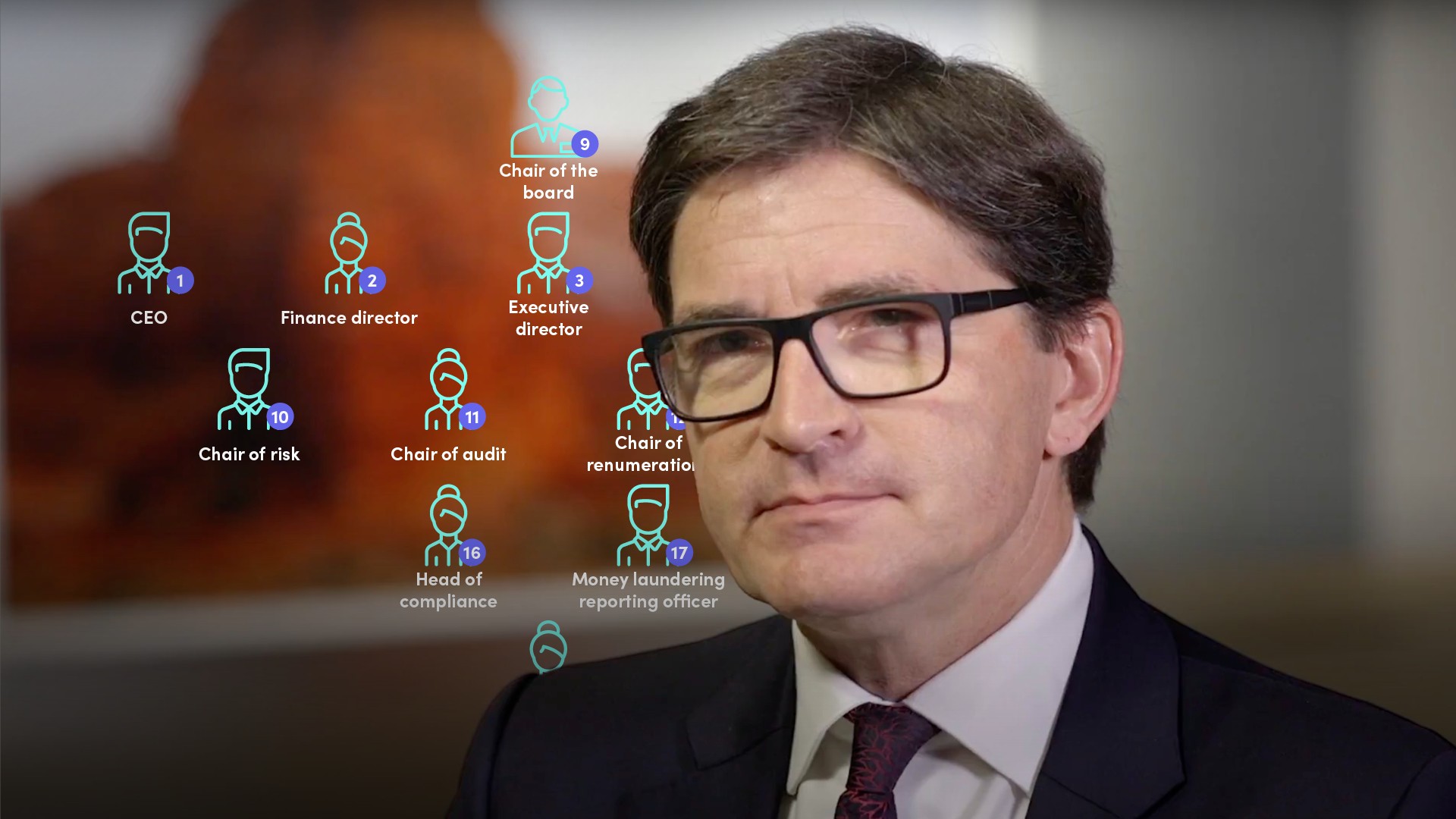
Key Terms and Functions under SMCR

Roger Miles
25 years: Behavoural science & conduct
In the previous video, Roger discussed the Senior Managers regime (SMR) of conduct regulation. In this video, Roger focuses on the language used to set out responsibilities under SMR and outlines the numbering system that the Conduct and Prudential regulators use to identify which role carries which responsibility.
In the previous video, Roger discussed the Senior Managers regime (SMR) of conduct regulation. In this video, Roger focuses on the language used to set out responsibilities under SMR and outlines the numbering system that the Conduct and Prudential regulators use to identify which role carries which responsibility.

Key Terms and Functions under SMCR
12 mins 48 secs
Key learning objectives:
Define key phrases used in SMF
Understand the numbering system of senior managers
Overview:
An understanding of SMR requires a knowledge of its vocabulary. SMR terms are defined along with a brief overview of the numbering that is assigned to each senior manager position.
What are some key SMR terms?
- Fit and proper
- Before any firm appoints someone into a senior manager (SM) role, that person has to be checked by the Conduct regulator to make sure they are of good character. Worst case, the regulator can veto an appointment if they don’t like what they find out about the candidate’s personal ethical choices. To hold a SM role you need to be certified as someone who has led a well-behaved moral life in business, someone who’s honest, without any criminal misdemeanours, bankruptcy or other serious moral questions; and that you are familiar with what this kind of role requires.
- Competence
- Here, in a bit of a change from the past where it was mainly about paper certification, conduct regulators now look for practical signs that you’re not simply relying on old qualifications from early in your career. Under conduct regulation, it is not enough simply to have qualified for a certificate as say an accountant or a securities trader at some point in the distant past. To prove you are a competent senior manager you will need to show how you are keeping up to date with the way that modern markets work, and particularly your markets.
- Required functions
- These are the most basic senior management roles needed by all firms to assure the regulator and reassure the public, that the firm plays by the rules and is not a front for a criminal enterprise.
- Statement of Responsibilities
- Each senior manager is required to set out their own understanding of what they are responsible for and will be held accountable for by the regulator. Each SM is expected to send their own statement to the conduct regulator when first appointed to the role and again each year that they continue to do the job.
- Responsibilities Map
- The map sets out each firm's specific arrangements for governance, management and designating responsibilities to individuals across the firm. The exercise of drawing up a responsibilities map, goes to the heart of how senior manager accountability is handled within a firm.
- Certification
- Staff in so-called Certification functions are employees, including SMs but not necessarily at senior level, who could pose a risk of significant harm to the firm or its customers.
- Material risk-takers
- Although this may seem quite self-evident, there is a lot of disagreement among firms as to how many of their staff, other than SMs, are engaged in material risk-taking and therefore how many of the wider employee base needs certifying.
- Attestation
- The name that many firms and their lawyers give to the process of putting together senior managers statements of responsibilities, any related certification, and each individual's takeaway from the role-mapping.
- Structured training
- Again this is an innocent looking phrase, but it actually means: is the SM taking part in a training programme that identifies them as qualifying for the FCA’s Training and Competence threshold?
What are some relevant SMF numbers?
Senior management functions, or SMFs, are in the regulator's own words, “roles where the people doing them need to be approved by the FCA ”, as defined in the regulator’s Handbook. Broadly speaking, it’s one person, one distinct set of responsibilities which don’t overlap with anyone else’s.
- Chief Executive: SMF1
- Finance Director: SMF2
- Head of Risk: SMF4
Other Execs are SMF 3s, although for larger firms there are special SMF numbers for the committee Chairs of Risk, Audit, Remuneration and Nominations who are SMFs 10, 11, 12 and 13 respectively. The Chair of the Board meanwhile is SMF9.
You may now be thinking, what happened to the other high numbers? The Conduct regulator is very interested in two of the control functions closest to the reporting pipeline: that’s why the Head of Risk is SMF4 and the Head of Internal Audit, SMF5. Finally, the Head of Operations also gets a key role, as SMF24.

Roger Miles
There are no available Videos from "Roger Miles"

